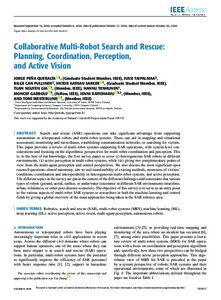Collaborative Multi-Robot Search and Rescue: Planning, Coordination, Perception, and Active Vision
Gabbouj M; Gia TN; Peña Queralta J; Pullinen BC; Raitoharju J; Sarker VK; Taipalmaa J; Tenhunen H; Westerlund T
Collaborative Multi-Robot Search and Rescue: Planning, Coordination, Perception, and Active Vision
Gabbouj M
Gia TN
Peña Queralta J
Pullinen BC
Raitoharju J
Sarker VK
Taipalmaa J
Tenhunen H
Westerlund T
IEEE-INST ELECTRICAL ELECTRONICS ENGINEERS INC
Julkaisun pysyvä osoite on:
https://urn.fi/URN:NBN:fi-fe2021042825682
https://urn.fi/URN:NBN:fi-fe2021042825682
Tiivistelmä
Search and rescue (SAR) operations can take significant advantage from supporting autonomous or teleoperated robots and multi-robot systems. These can aid in mapping and situational assessment, monitoring and surveillance, establishing communication networks, or searching for victims. This paper provides a review of multi-robot systems supporting SAR operations, with system-level considerations and focusing on the algorithmic perspectives for multi-robot coordination and perception. This is, to the best of our knowledge, the first survey paper to cover (i) heterogeneous SAR robots in different environments, (ii) active perception in multi-robot systems, while (iii) giving two complementary points of view from the multi-agent perception and control perspectives. We also discuss the most significant open research questions: shared autonomy, sim-to-real transferability of existing methods, awareness of victims' conditions, coordination and interoperability in heterogeneous multi-robot systems, and active perception. The different topics in the survey are put in the context of the different challenges and constraints that various types of robots (ground, aerial, surface, or underwater) encounter in different SAR environments (maritime, urban, wilderness, or other post-disaster scenarios). The objective of this survey is to serve as an entry point to the various aspects of multi-robot SAR systems to researchers in both the machine learning and control fields by giving a global overview of the main approaches being taken in the SAR robotics area.
Kokoelmat
- Rinnakkaistallenteet [19250]
